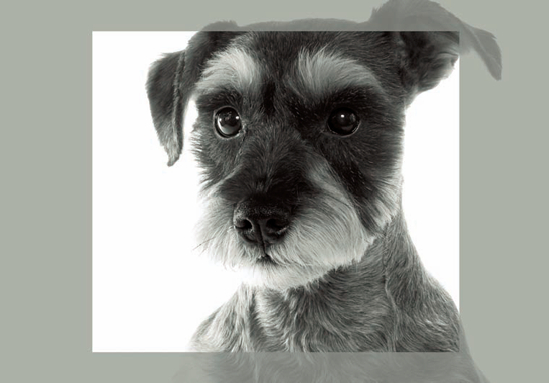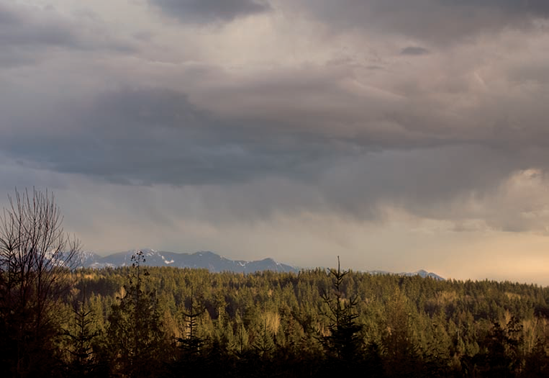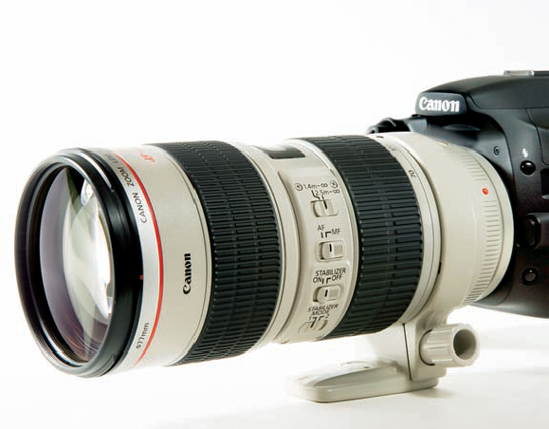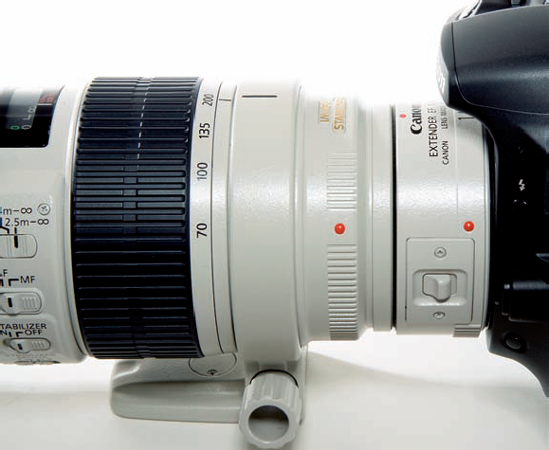The lens is the eye of the camera, and the importance of quality lenses can't be overstated. With a high-quality lens, pictures have stunning detail, high resolution, and snappy contrast. Conversely, low-quality optics produce marginal picture quality. And as most photographers know, over time your investment in lenses far exceeds the money invested in the camera body. For these reasons, making studied decisions on lens purchases pays off for years to come in getting great image sharpness and quality and in building a solid photography system.
This chapter looks at the lenses available to help you make decisions about lenses you can add to your system, to enhance the type of photography you most enjoy.
The Rebel XSi/450D image sensor is 1.6 times smaller than a traditional 35mm film frame. It is important to know the sensor size because it not only determines the size of the image but also affects the angle of view of the lenses you use. A lens's angle of view is how much of the scene, side to side and top to bottom, that the lens includes in the image. For example, a 15mm Fisheye lens has a 180-degree angle of view. By contrast, a 200mm lens has a scant 12-degree angle of view.
Further, the angle of view for all lenses you use on the XSi/450D is reduced by a factor of 1.6 times at any given focal length, producing an image that is equal to that of a lens with 1.6 times the focal length. That means that a 100mm lens on a 35mm film camera becomes the equivalent of a 160mm on the XSi/450D. Likewise, a 50mm normal lens becomes the equivalent of an 80mm lens, which is equivalent to a short telephoto lens on a full 35mm-frame size.
Tip
The EF-S lenses are usable only on the cropped-frame cameras, including the XSi/450D, due to a redesigned rear element that protrudes back into the camera body.
This focal length multiplication factor works to your advantage with a telephoto lens because it effectively increases the lens's focal length (although technically the focal length doesn't change). And because telephoto lenses tend to be more expensive than other lenses, you can buy a shorter and less expensive telephoto lens and get 1.6 times more magnification at no extra cost.
The focal length multiplication factor works to your disadvantage with a wide-angle lens because the sensor sees less of the scene when the focal length is magnified by 1.6x. But, because wide-angle lenses tend to be less expensive than telephoto lenses, you can buy an ultrawide 14mm lens to get the equivalent of an angle of view of 22mm.
Because telephoto lenses provide a shallow depth of field, it seems reasonable to assume that the conversion factor would produce the same depth-of-field results on the XSi/450D that a longer lens gives. That isn't the case, however. Although an 85mm lens on a full 35mm-frame camera is equivalent to a 136mm lens on the XSi/450D, the depth of field on the XSi/450D matches the 85mm lens, not the 136mm lens.

Figure 8.1. This image shows the approximate difference in image size between a 35mm film frame and the XSi/450D. The smaller image size represents the XSi/450D's image size.
This depth-of-field principle holds true for enlargements. The depth of field in the print is shallower for the longer lens on a full-frame camera than it is for the XSi/450D.
Lenses range in focal lengths (the amount of the scene included in the frame) from Fisheye to super-telephoto and are generally grouped into three main categories: wide angle, normal, and telephoto. There are also macro lenses that serve double-duty as either normal or telephoto lenses and offer macro capability.
Wide-angle lenses offer a wide view of a scene. They traditionally are 15mm, or Fisheye, or 16mm to 35mm with an angle of view ranging from 180 degrees to 63 degrees. Simply stated, lenses shorter than 50mm are considered wide angle on full-frame 35mm image sensors. A wide-angle lens offers sharp detail from foreground to background, especially at narrow apertures such as f/22. The amount of reasonably sharp focus front to back in an image is referred to as depth of field.
Note
Depth of field is discussed in detail in Chapter 6.
Normal lenses offer an angle of view and perspective very much as your eyes see the scene. On full 35mm-frame cameras, 50mm to 55mm lenses are considered normal lenses. However, with the focal length conversion factor of 1.6x on the XSi/450D, a 35mm lens is closer to the "normal" focal length. Normal lenses provide extensive depth of field (particularly at narrow apertures) and are compact in size and versatile.
Telephoto lenses offer a narrow angle of view, enabling close-ups of distant scenes. On full 35mm-frame cameras, lenses with focal lengths longer than 50mm are considered telephoto lenses. Telephoto lenses begin with the short 60mm lens and go through to the super-telephoto 800mm lenses. Telephoto lenses offer shallow depth of field, providing a softly blurred background, particularly at wide apertures. And, of course, they offer a closer view of distant scenes and subjects.
Macro lenses are designed to provide a closer lens-to-subject focusing distance than non-macro lenses. Depending on the lens, the magnification ranges from half-life size (0.5x) to 5x magnification. Thus, objects as small as a penny or a postage stamp can fill the frame, while nature macro shots can reveal breathtaking details that are commonly overlooked or are not visible to the human eye. By contrast, non-macro lenses typically allow maximum magnifications of about one-tenth life size (0.1x). Macro lenses are single focal-length lenses that come in normal and telephoto focal lengths.
Within the basic focal-length lens categories, you can choose between zoom and prime (also called single focal-length) lenses. The most basic difference between zoom and prime lenses is that zoom lenses offer a range of focal lengths in a single lens while prime lenses offer a fixed, or single, focal length. There are additional distinctions that come into play as you evaluate which type of lens is best for your shooting needs.
Zoom lenses, with their variable focal length, are versatile because they offer multiple and variable focal lengths in a single lens. Available in wide-angle and telephoto ranges, zoom lenses can maintain focus during zooming. To keep the lens size compact, and to compensate for aberrations with fewer lens elements, most zoom lenses use a multigroup zoom with three or more movable lens groups.
Some zoom lenses are slower than single focal length lenses, and getting a fast zoom lens usually comes at a higher price. In addition, some zoom lenses have a variable aperture, which means that the minimum aperture changes at different zoom settings (discussed in the following sections).
The obvious advantage of a zoom lens is the ability to quickly change focal lengths and image composition without changing lenses. In addition, only two or three zoom lenses are needed to encompass the focal range you use most often for everyday shooting. For example, carrying a Canon EF-S 17–55mm IS USM lens and a Canon EF 55–200mm f/4.5-5.6 II USM lens, or a similar combination, provides the focal range needed for everything from landscape to portrait to some wildlife photography.
A zoom lens also offers the creative freedom of changing image composition with the turn of the zoom ring — all without changing your shooting position or changing lenses. Most mid-priced and more expensive zoom lenses offer high-quality optics that produce sharp images with excellent contrast. As with all Canon lenses, full-time manual focusing is available by switching the button on the side of the lens to MF (Manual Focus).
Although zoom lenses allow you to carry around fewer lenses, they tend to be heavier than their single focal-length counterparts. Mid-priced, fixed-aperture zoom lenses also tend to be slow, meaning that with maximum apertures of only f/4.5 or f/5.6, they call for slower shutter speeds that, in turn, limit your ability to get sharp images when handholding the camera, provided that the lens does not have image stabilization (IS), a technology that is detailed later in this chapter.
Some zoom lenses have variable apertures. A variable-aperture lens of f/4.5 to f/5.6 means that at the widest focal length, the maximum aperture is f/4.5 and at the telephoto end of the focal range, the maximum aperture is f/5.6. In practical terms, this limits the versatility of the lens at the longest focal length for shooting in all but bright light unless you set a high ISO. And unless you use a tripod and your subject is stone still, your ability to get a tack-sharp picture in lower light at f/5.6 will be questionable.
Note
For a complete discussion on aperture, see Chapter 6.
More expensive zoom lenses offer a fixed and fast maximum aperture, meaning that with maximum apertures of f/2.8, they allow faster shutter speeds that enhance your ability to get sharp images when handholding the camera. But the lens speed comes at a price: the faster the lens, the higher the price.
Long the mainstay of photographers, prime, or single focal-length, lenses offer a fixed focal length. Prime lenses such as Canon's venerable EF 50mm f/1.4 USM and EF 100mm f/2.8 Macro USM are only two of a full lineup of Canon prime lenses. With a prime lens, you cannot zoom, so you must move closer to or farther from your subject, or change lenses to change image composition. Single focal-length lenses generally have a brighter maximum aperture than zoom lenses, which offer a broader range of creative expressiveness. Prime lenses produce excellent sharpness and contrast.
Unlike zoom lenses, prime lenses tend to be fast with maximum apertures of f/2.8 or wider on non-telephoto lenses and on some telephoto lenses. Wide apertures allow fast shutter speeds, and that combination allows you to handhold the camera in lower light and still get a sharp image. Compared to zoom lenses, single focal-length lenses are lighter and smaller.
In addition, many photographers believe that single focal-length lenses are sharper and provide better image quality overall than zoom lenses.
Most prime lenses are lightweight, but you need more of them to have lenses that run the full focal-length range. Prime lenses also limit the options for some on-the-fly composition changes that are possible with zoom lenses.
Canon uses several designations and lens construction technologies that are helpful to know as you consider lenses to add to your camera system.
EF/EF-S lens mount. This designation identifies the type of mount that the lens has and the camera accepts. The EF lens mount provides not only quick mounting and removal of lenses, but it also provides the communication channel between the lens and the camera body. The EF mount is fully electronic and resists abrasion, shock, and play, and needs no lubrication like other lens mounts. The EF system does a self-test using a built-in microcomputer so that you're alerted of possible malfunctions of the lens via the camera's LCD display. In addition, if you use lens extenders, the exposure compensation is automatically calculated. The EF-S lens mount is designed specifically for cropped-image-sensor cameras such as the XSi/450D. These lenses tend to be more affordable with good optical resolution. Because EF-S lenses have a shorter back focus than EF lenses, the EF-S lenses won't be compatible should you eventually buy a full-frame EOS camera.
USM. When you see USM, it indicates the lens features a built-in ultrasonic motor with a very quiet focusing mechanism. The motor is powered by the camera; however, because the lens has its own focusing motor, you get exceptionally fast focus. USM lenses use electronic vibrations created by piezoelectric ceramic elements to provide quick and quiet focusing action with near instantaneous starts and stops.
In addition, lenses with a ring-type ultrasonic motor offer full-time manual focusing without the need to first switch the lens to manual focus. This design is offered in the large-aperture and super-telephoto lenses. A second design, the micro-ultrasonic motor, provides the advantages of this technology in the less expensive EF lenses.
L-series lenses. Canon's L-series lenses feature a distinctive red ring on the outer barrel, or in the case of telephoto and super-telephoto lenses, are distinguished by Canon's well-known white barrel. The distinguishing characteristics of L-series lenses, in addition to their sobering price tags, are a combination of technologies that provide outstanding optical performance. L-series lenses include one or more of the following technologies and features:
UD/Fluorite elements. Ultralow Dispersion (UD) glass elements help minimize color fringing or chromatic aberration. This glass also provides improved contrast and sharpness. UD elements are used, for example, in the EF 70–200mm f/2.8L IS USM and EF 300mm f/4L IS USM lenses. On the other hand, Fluorite elements, which are used in super-telephoto L-series lenses, reduce chromatic aberration. Lenses with UD or Fluorite elements are designated as CaF2, UD, and/or S-UD.
Aspherical elements. This technology is designed to help counteract blurred images that happen as a result of spherical aberration. Spherical aberration happens when wide-angle and fast normal lenses cannot resolve into a sharp point of focus light rays coming into the lens from the center with those coming from the edge. An aspherical element uses a varying curved surface to ensure that the entire image plane appears focused. These types of optics help correct distortion in ultra-wide-angle lenses as well. Lenses with aspherical elements are designated as AL.
Dust, water-resistant construction. For any photographer who shoots in inclement weather, having a lens with adequate weather sealing is critical. The L-series EF telephoto lenses stand up well to inclement weather and heavy use. L-series lenses have rubber seals at the switch panels, exterior seams, drop-in filter compartments, and lens mounts to make them both dust and water resistant. Moving parts, including the focusing ring and switches, are also designed to keep out environmental contaminants.
Image stabilization. Lenses labeled as IS lenses offer image stabilization, which is detailed later in this chapter. IS lenses allow you to handhold the camera at light levels that normally require a tripod. The amount of handholding latitude varies by lens and the photographer's ability to hold the lens steady, but you can generally count on one to three more f-stops of stability with an IS lens than with a non-IS lens.
Macro. Macro lenses, which are covered in detail later in this chapter, enable close-up focusing with subject magnification of one-half to life-size and a maximum aperture of f/25.
Full-time manual focusing. An advantage of Canon lenses is the ability to use autofocus, and then tweak focus manually using the lens's focusing ring without switching out of autofocus mode or changing the switch on the lens from the AF (Autofocus) to MF setting. Full-time manual focusing comes in very handy, for example, with macro shots and when using extension tubes.
Inner and rear focusing. Lenses' focusing groups can be located in front of or behind the lens diaphragm, both of which allow for compact optical systems with fast AF. Lenses with rear optical focusing, such as the EF 85mm f/1.8 USM, focus faster than lenses that move their entire optical system, such as the EF 85mm f/1.2L II USM.
Floating system. Canon lenses use a floating system that dynamically varies the gap between key lens elements based on the focusing distance. As a result, optical aberrations are reduced or suppressed through the entire focusing range. In comparison, optical aberrations in non-floating system lenses are corrected only at commonly used focusing distances. At other focusing distances, particularly at close focusing distances, the aberrations appear and reduce image quality.
AF Stop. The AF Stop button, offered on several EF IS super-telephoto lenses, allows you to temporarily suspend autofocusing of the lens. For example, if the lens is focusing and an obstruction comes between the lens and the subject, you can press the AF Stop button to stop focusing to prevent the focusing from being thrown off. Once the obstruction passes by the subject, the focus remains on the subject, provided that the subject hasn't moved, so that you can resume shooting.
Diffractive optics. Diffractive optics (DO) bonds diffractive coatings to the surfaces of two or more lens elements. The elements are then combined to form a single multilayer DO element designed to cancel chromatic aberrations at various wavelengths when combined with conventional glass optics. Diffractive optics result in smaller and shorter telephoto lenses without compromising image quality. For example, the EF 70–300mm f/4.5-5.6 DO IS USM lens is 28 percent shorter than the EF 70–300mm f/4.5-5.6 IS USM lens.
A wide-angle lens is a versatile lens for capturing subjects ranging from large groups of people to sweeping landscapes, as well as for taking pictures in places where space is cramped. The distinguishing characteristic of wide-angle lenses is the range of the angle of view. Within the Canon lens line-up, you can choose angles of view from the 15mm Fisheye lens, which offers a 180-degree angle of view, to the 35mm lens, which offers a 63-degree angle of view, not counting the 1.6x focal length multiplication factor.

Figure 8.7. A strong cloud formation and light on the hillside attracted me to this scene, and the Canon EF 24–70mm f/2.8L USM lens provides excellent sharpness for this image. Exposure: ISO 100, f/11, 1/125 second.
When you shoot with a wide-angle lens, keep these lens characteristics in mind:
Extensive depth of field. Particularly at small apertures from f/11 to f/32, the entire scene, front to back, will be in acceptably sharp focus. This characteristic gives you slightly more latitude for less-than-perfectly focused pictures.
Narrow, fast apertures. Wide-angle lenses tend to be faster (meaning they have wider apertures) than telephoto lenses. As a result, these lenses are good choices for shooting when the lighting conditions are not optimal.
Distortion. Wide-angle lenses can distort lines and objects in a scene, especially if you tilt the camera up or down when shooting. For example, if you tilt the camera up to photograph skyscrapers with a wide-angle lens mounted, the lines of the buildings tend to converge toward the center of the frame and the buildings appear to lean backward (also called keystoning). You can use this wide-angle lens characteristic to creatively enhance a composition, or you can move back from the subject and keep the camera parallel to the main subject to help avoid the distortion.
Perspective. Wide-angle lenses make objects close to the camera appear disproportionately large. You can use this characteristic to move the closest object visually forward in the image, or you can move back from the closest object to reduce the effect. Moderate wide-angle lenses are popular for portraits, but if you use a wide-angle lens for close-up portraiture, keep in mind that the lens exaggerates the size of facial features closest to the lens.
Tip
If you're shopping for a wide-angle lens, look for aspherical lenses. These lenses include a nonspherical element that helps reduce or eliminate optical flaws to produce better edge-to-edge sharpness and reduce distortions.
Choose a telephoto lens to take portraits and to capture distant subjects such as birds, buildings, wildlife, and landscapes. Short telephoto lenses such as 85mm and 100mm are ideal for portraits, while long lenses (200mm to 800mm) allow you to photograph distant birds, wildlife, and athletes. When photographing wildlife, long lenses also allow you to keep a safe distance from the subject.
When you shoot with a telephoto lens, keep these lens characteristics in mind:
Shallow depth of field. Telephoto lenses magnify subjects and provide a limited range of sharp focus. At wide apertures, such as f/4, you can reduce the background to a soft blur. Because of the shallow depth of field, there is no latitude for anything except tack-sharp focus. All Canon lenses include full-time manual focusing that you can use to fine-tune the camera's autofocus.
Narrow coverage of a scene. Because the angle of view is narrow with a telephoto lens, much less of the scene is included in the image. You can use this characteristic to exclude distracting scene elements from the image.
Slow speed. Mid-priced telephoto lenses tend to be slow; the widest aperture is often f/4.5 or f/5.6, which limits the ability to get sharp images without a tripod in all but bright light unless the lens has image stabilization. And because of the magnification, even the slight movement when handholding the camera and lens or in subject movement is exaggerated.
Perspective. Telephoto lenses tend to compress perspective, making objects in the scene appear stacked together.
If you're shopping for a telephoto lens, look for those with UD glass or Fluorite elements that improve contrast and sharpness. Image stabilization counteracts blur caused by handholding the camera.
A normal, or 50–55mm, lens is perhaps the most often overlooked lens. This lens, which Canon categorizes as a "standard" lens, was long the primary or only lens that photographers of past decades used, and it remains a classic that provides outstanding sharpness and contrast. On a 35mm film camera, a normal lens is 50mm, but on the XSi/450D, a 35mm lens is closer to normal considering the focal-length conversion factor. Normal lenses are small, light, often affordably priced, and offer fast and super-fast apertures such as f/1.4 and faster.
When you shoot with a normal lens, keep these lens characteristics in mind:
Natural angle of view. A 50mm lens closely replicates the sense of distance and perspective of the human eye. This means the final image will look much as you remember seeing it when you made the picture.
Little distortion. Given the natural angle of view, the 50mm lens retains a normal sense of distance, especially when you balance the subject distance, perspective, and aperture.
Creative expression. With planning and a good understanding of the 50mm lens, you can use it to simulate both wide-angle and medium telephoto lens effects. For example, by shooting at a narrow aperture and at a low- or high-angle shooting position, you can create the dynamic feeling of a wide-angle lens but without the distortion. On the other hand, a large aperture and a conventional shooting angle create results similar to that of a medium-telephoto lens.
Macro lenses open a new world of photographic possibilities by offering extreme levels of magnification. In addition, the reduced focusing distance allows beautiful, moderate close-ups as well as extreme close-ups of flowers and plants, animals, raindrops, and everyday objects. The closest focusing distance can be further reduced by using extension tubes.
Normal and telephoto lenses offer macro capability. Because these lenses can be used at their normal focal length as well as for macro photography, they do double-duty. Macro lenses offer one-half or life-size magnification.

Figure 8.9. A normal focal length, used for this image, provides an angle of view similar to that of the human eye. Exposure: ISO 400, f/22, 1/125 second, Canon EF 24–105mm, f/4L IS USM lens zoomed to 55mm.

Figure 8.10. Canon offers several macro lenses, including the EF 180mm f/3.5L Macro USM (left), which offers 1x (life-size) magnification and a minimum focusing distance of 0.48m/1.6 ft. Also shown here is the Canon EF 100mm f/2.8 Macro USM lens.

Figure 8.11. The EF 100mm is one of my standard walk-around lenses, and I used it to capture this image. Exposure: ISO 100, f/11, 2 seconds.
Based on focal length and magnification, choose the lens that best suits the kinds of subjects you want to photograph. I often use the 100mm, f/2.8 Macro USM lens as a walk-around lens because much of my work lends itself to a short telephoto focal length or to macro work. Other photographers would never think of using a prime lens as a walk-around lens, but for me, the 100mm is often ideal.
Referred to as TS-E, tilt-and-shift lenses allow you to alter the angle of the plane of focus between the lens and sensor plane to provide a broad depth of field even at wide apertures and to correct or alter perspective at almost any angle. In short, TS-E lenses allow you to correct perspective distortion and control focusing range.
Tilt movements allow you to bring an entire scene into focus, even at maximum apertures. By tilting the lens barrel, you can adjust the lens so that the plane of focus is uniform on the focal plane, thus changing the normally perpendicular relationship between the lens's optical axis and the camera's focal plane. Alternately, reversing the tilt has the opposite effect of greatly reducing the range of focusing.
Shift movements avoid the trapezoidal effect that results from using wide-angle lenses pointed up — to take a picture of a building, for example. Keeping the camera so that the focal plane is parallel to the surface of a wall and then shifting the TS-E lens to raise the lens results in an image with the perpendicular lines of the structure being rendered perpendicular and with the structure being rendered with a rectangular appearance.

Figure 8.12. IS provided a level of insurance for sharpness in this scene where I handheld an EF 100–400mm f/5.6L IS USM lens zoomed to 100mm. Exposure: ISO 200, f/8, 1/60 second.
All of Canon's TS-E lenses are manual focus only. These lenses, depending on the focal length, are excellent for architectural, interior, merchandise, nature, and food photography.
Image stabilization (IS) is a technology that counteracts motion blur from handholding the camera. Whether IS belongs in the lens or in the camera is a matter of debate. But for Canon, the argument is that stabilization belongs in the lens because different lenses have different stabilization needs. If you've shopped for lenses lately, you know that IS comes at a premium price, but IS is often worth the extra money because, in practice, you gain from one to three f-stops of stability — and that means that you may be able to leave the tripod at home.
Not taking IS into account, the rule of thumb for handholding the camera is 1/[focal length]. For example, the slowest shutter speed at which you can handhold a 200mm lens and avoid motion blur is 1/200 second. If the handholding limit is pushed, then shake from handholding the camera bends light rays coming from the subject into the lens relative to the optical axis, and the result is a blurry image.
With an IS lens, miniature sensors and a high-speed microcomputer built into the lens analyze vibrations and apply correction via a stabilizing lens group that shifts the image parallel to the focal plane to reduce the effect of camera shake. The lens detects camera motion via two gyro sensors — one for yaw and one for pitch. The sensors detect the angle and speed of shake. Then the lens shifts the IS lens group to suit the degree of shake to steady the light rays reaching the focal plane.
Stabilization is particularly important with long lenses, where the effect of shake increases as the focal length increases. As a result, the correction needed to cancel camera shake increases proportionately.
But what about when you want to pan or move the camera with the motion of a subject? Predictably, IS detects panning as camera shake and the stabilization then interferes with framing the subject. To correct this, Canon offers two modes on IS lenses. Mode 1 is designed for stationary subjects. Mode 2 shuts off IS in the direction of movement when the lens detects large movements for a preset amount of time. So when panning horizontally, horizontal IS stops but vertical IS continues to correct any vertical shake during the panning movement.
IS lenses come at a higher price, but they are very effective for low-light scenes and telephoto shooting.
There are a variety of ways to increase the focal range and decrease the focusing distance to provide flexibility for the lenses you already own. These accessories are not only economical, but they also extend the range and creative options of existing and new lenses. Lens accessories can be as simple as using a lens hood to avoid flare; adding a tripod mount to quickly change between vertical and horizontal positions without changing the optical axis or the geometrical center of the lens; or adding a drop-in or adapter-type gelatin filter holder. Other options include using lens extenders, extension tubes, and close-up lenses.
For relatively little cost, you can increase the focal length of any lens by using an extender. An extender is a lens set in a small ring mounted between the camera body and a regular lens. Canon offers two extenders, a 1.4x and 2x, that are compatible only with L-series Canon lenses. Extenders can also be combined to get even greater magnification.
For example, using the Canon EF 2x II extender with a 200mm lens doubles the lens's focal length to 400mm, and then you can apply the 1.6x focal length conversion factor to get the equivalent of a 640mm lens. Using the Canon EF 1.4x II extender increases a 200mm lens to 280mm or 448mm with the 1.6x conversion factor.
Extenders generally do not change camera operation, but they do reduce the amount of light reaching the sensor. The EF 1.4x II extender decreases the light by one f-stop, and the EF 2x II extender decreases the light by two f-stops. In addition to being fairly lightweight, the obvious advantage of extenders is that they can reduce the number of telephoto lenses you carry.
The 1.4x extender can be used with fixed focal-length lenses 135mm and longer (except the 135mm f/2.8 Softfocus lens). The 1.4x extender can be used with any lens that has an f/4 or faster maximum aperture. With the EF 2x II, the extender can be used with any lens that has an f/2.8 or faster maximum aperture. Autofocus is possible if the lens has an f/2.8 or faster maximum aperture and compatible image stabilization lenses continue to provide stabilization. The extenders offer weather-resistant construction and antireflective surfaces in the barrel of the extender.
Extension tubes are close-up accessories that provide magnification from approximately 0.3 to 0.7 and can be used on many EF lenses, though there are exceptions. Extension tubes are placed between the camera body and lens and connect to the camera via eight electronic contact points. The function of the camera and lens is unchanged, and you can combine extension tubes for greater magnification.
Canon offers two extension tubes, the EF 12 II and the EF 25 II. Magnification differs by lens, but with the EF12 II and standard zoom lenses, it is approximately 0.3 to 0.5. With the EF 25 II, magnification is 0.7. When combining tubes, you may need to focus manually.
Extension tube EF 25 II is not compatible with the EF 15mm f/2.8 Fisheye, EF 14mm f/2.8L USM, EF 20mm f/2.8 USM, EF 24mm f/1.4L USM, EF 20–35mm f/3.5-4.5 USM, EF 24–70mm f/2.8L USM, MP-E 65mm f/2.8 1-5x Macro Photo, TS-E 45mm f/2.8, and EF-S 18–55mm f/3.5-5.6 (at wide angles) lenses.
Additionally, you can use screw-in close-up lenses. Canon offers three lenses that provide enhanced close-up photography. The 250D/500D series uses a double-element design for enhanced optical performance. The 500D series features single-element construction for economy. The working distance from the end of the lens is 25cm for the 250D, and 50cm for the 500D.







